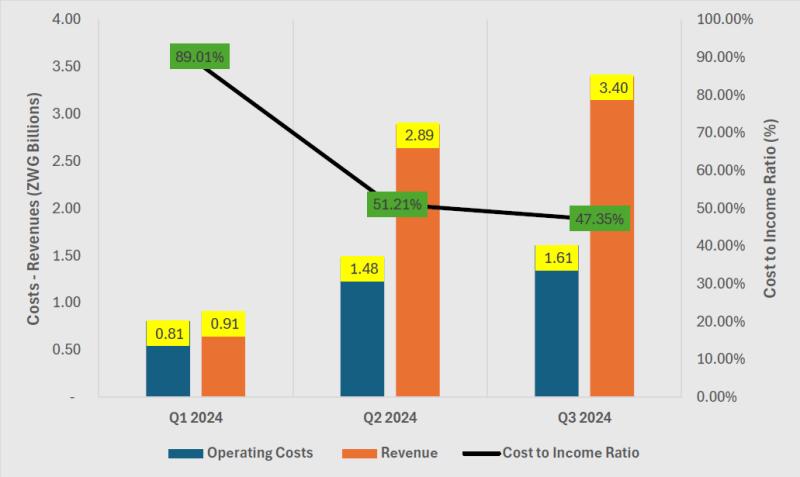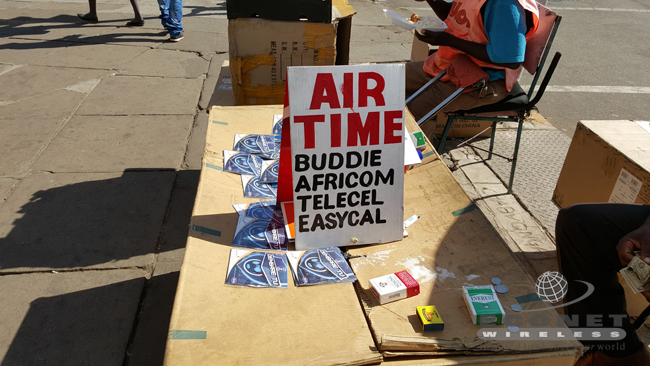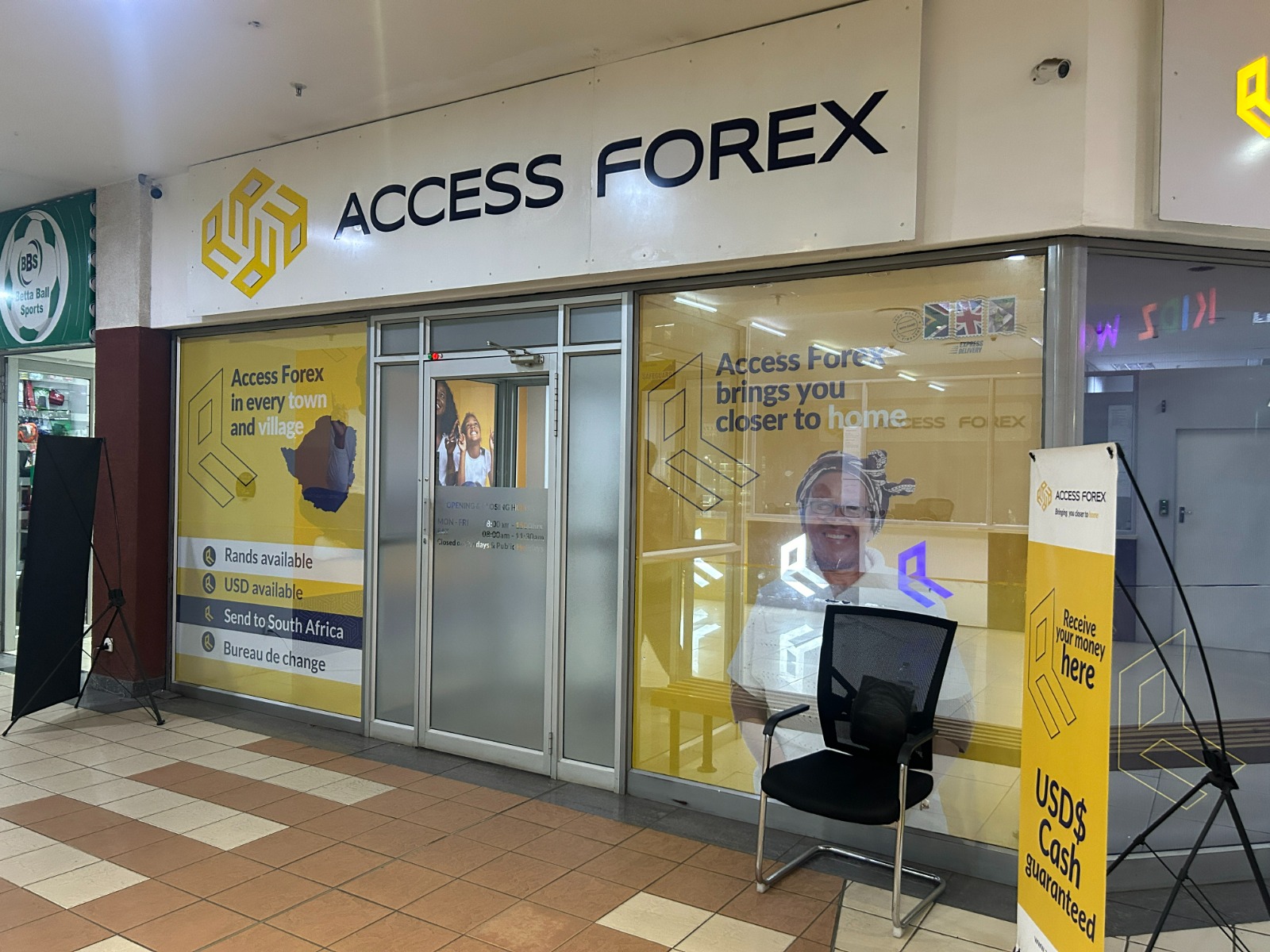In the third quarter of 2024, Zimbabwe’s mobile network operators (MNOs) saw some interesting changes in their revenues, costs, and investments. Let’s get into it.
Revenue Growth
Mobile operators’ total revenue grew by 17.66%, reaching ZWG 3.40 billion (up from ZWG 2.89 billion in the previous quarter). This growth is a good sign, especially here in Zimbabwe, where the economy has been struggling.
We have seen these MNOs post higher percentage revenue increases in the past, but in those times, there was significantly more currency instability. In a relatively more stable Q3 2024, a 17.66% revenue increase is impressive.
Potraz suggests that this increase might be due to a stable exchange rate during this period, which helped businesses and consumers plan better. I think we can all agree that this was probably the biggest factor.
One lovely benefit of this revenue growth is that companies usually invest more in their operations when they’re making more money, as you will see. We stand to benefit.
Slower Rising Costs
While revenues grew impressively, the operating costs of MNOs only increased by 8.62%, from ZWG 1.48 billion to ZWG 1.61 billion. This slower pace of cost increase compared to revenue growth points to better cost management, or it could just be that prices were exorbitantly increased.
Essentially, operators are becoming more efficient in managing their expenses. Unfortunately, this efficiency came with retrenchment. As you may recall, Econet and EcoCash were reunited, and that whole reconstruction, as it’s called, was taking shape in Q3 2024. That led to some retrenchment to streamline the business and remove any duplicate roles.
As you would imagine, remuneration is usually one of the biggest operational costs any business faces. So, when the biggest operator had those retrenchment benefits on its operational costs, it obviously helped keep sector costs lower.
Anyway, for Zimbabwe, where inflation and economic instability have massacred the cost structure for businesses, this indicates that operators are learning to do more with less. The MNOs better do that, or they will follow the road OK Zimbabwe is on.
The impact of the relative exchange rate stability in Q3 2024 cannot be underestimated. In a dual currency system, costs for things like equipment (priced in USD) can rise quickly if the local currency loses value. This puts pressure on operators to either absorb the costs or pass them on to consumers through higher prices. If there is no significant currency depreciation, then operating costs will be lower. It’s that simple.
Big Jump in Investments
The most significant change was in capital expenditure (CAPEX), which skyrocketed by 268%, from ZWG 164.77 million to ZWG 607.07 million. This means mobile operators are investing heavily in things like network infrastructure, such as upgrading to faster 4G and 5G technologies.
You don’t need telling why this is great news:
- Improved Services: More investment in infrastructure means better network coverage, faster internet speeds, and more reliable services for us.
- Economic Growth: These investments can create jobs and stimulate the economy. For example, building new base stations or upgrading existing ones requires labour and materials, which can benefit local businesses.
- Dual Currency Challenges: However, in a dual currency system, these investments might be complicated. The equipment is imported (and priced in USD), and operators need enough foreign currency to make these purchases. If the local currency weakens, this could become a challenge.
Profitability

The graph shows the trend in operating costs, revenues, and the cost-to-income ratio for Zimbabwe’s mobile network operators from Q1 to Q3 of 2024. Revenue has increased significantly from ZWG 0.91 billion in Q1 to ZWG 3.40 billion in Q3. Operating costs have also risen but at a slower pace, from ZWG 0.81 billion in Q1 to ZWG 1.61 billion in Q3. Meanwhile, the cost-to-income ratio has steadily declined from 89.01% in Q1 to 47.35% in Q3, indicating improved efficiency and profitability. This shows that despite rising operational expenses, revenue growth has outpaced costs.
The Potraz Sector report for Q3 2024 shows that the financial health of operators improved, with better profitability ratios. This simply means that despite rising costs, operators are managing to make more money relative to what they’re spending.
If operators can maintain this balance between revenue growth and cost management, they’ll be in a good position to keep investing in the network. Or give themselves huge bonuses if they so choose. However, if inflation or currency instability worsens, this balance could go out of whack.
If operators are doing well financially, they might be able to offer more affordable services or better packages to consumers. This could be partly why we saw ZWG prices fall for some operators on select data bundles in February 2025.
Why This Should Interest You
The growth in revenue and investment means that mobile services are likely to improve in the near future. More reliable networks, faster speeds, and better services are a direct result of these investments. However, one key issue remains: the cost of mobile services.
As mobile data usage increases, especially with the rise of unlimited data packages, affordability remains a concern. We might see a growing divide between the haves and the have-nots if the data pricing issue is not resolved. If you’re reading this you’re in the ‘haves’ camp.
While the report indicates that MNOs are becoming more profitable and managing costs efficiently, the challenge remains ensuring that service improvements don’t come at a price too high for the average Zimbo.
Conclusion
In conclusion, the Q3 report shows a positive trend for MNOs in Zimbabwe. Revenue growth, better cost management, and huge investments in infrastructure highlight a sector that is preparing for the future.
I would love to believe the hype that Starlink brought to the market may have influenced the huge infrastructure investments. The MNOs probably saw that the future could be stolen from them if they didn’t act.
However, in a dual currency economy, the question remains whether Zimbos will feel the impact of these investments in terms of improved services without facing higher costs. For now, in mid-February, ZWG data prices have fallen for some, so yeah, these are good signs.
Looking ahead, it’s likely that network improvements will continue, but the affordability of mobile services will remain a huge issue. For MNOs to truly succeed, they will need to balance the need for infrastructure development with the reality of the economic challenges faced by their customers.
The #DataMustFall cries are still raging, and so that balance is yet to be struck.














Comments
One response
Data and bank charges are are real gripe in this country. Yes hey hid behind costs… Bunas soon as something innovative or cheaper comes the costs disappear. Case in point ecocash vs banks. Starlink s telecoms. We need more competition to drive prices down. And honestly 4% to send locally is riduclous